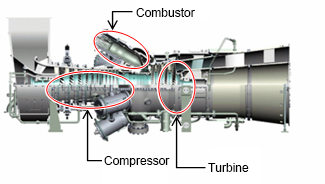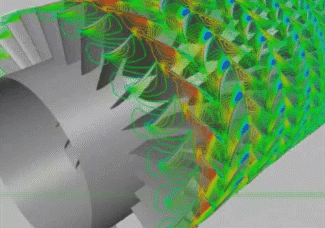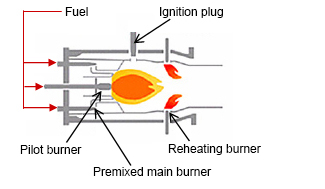Generating Power with a Low Environmental Load
Technologies for reducing the pollutants emitted by power generating engines.
Compressor
The compressor in a gas turbine takes in air at atmospheric pressure and then feeds it to the combustor at high pressure. Consequently, it has a considerable influence on the overall efficiency of the gas turbine.
When designing the blades for a compressor, KHI optimizes their shapes using computational fluid dynamics (CFD) analysis technology.
Since the compressor consists of a large number of blades that rotate at ultra-high speed, the behavior of the air that flows through it is very complicated. We are able to evaluate all of the blade rows in a single operation by using an advanced analysis technology.

Structure of a gas turbine

Gas turbine CFD analysis
Combustor
The combustor injects fuel into the hot high-pressure air that has been fed into it from the compressor for combustion. It then feeds the combustion gas, which has been further heated, to the gas turbine. Its performance affects the concentration of pollutants in the exhaust gas.
These pollutants are nitrogen oxide (NOx) and carbon monoxide (CO). More NOx is emitted at higher combustion gas temperatures, while more CO is emitted at lower temperatures. Therefore, the combustor must regulate the temperature to keep them in balance.
KHI has achieved a level of environmental performance that ranks among the best in the world through the use of lean premixed combustion and its proprietary reheating system.

Dry low-emission combustor





